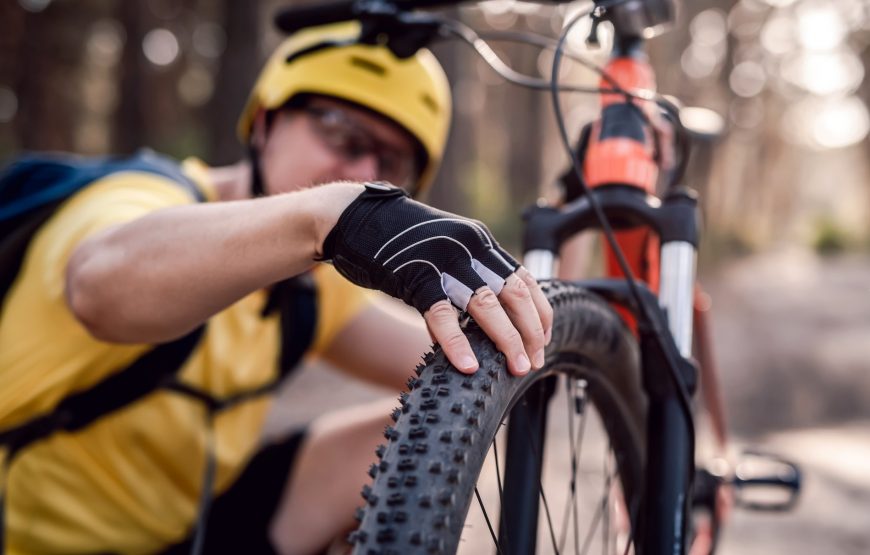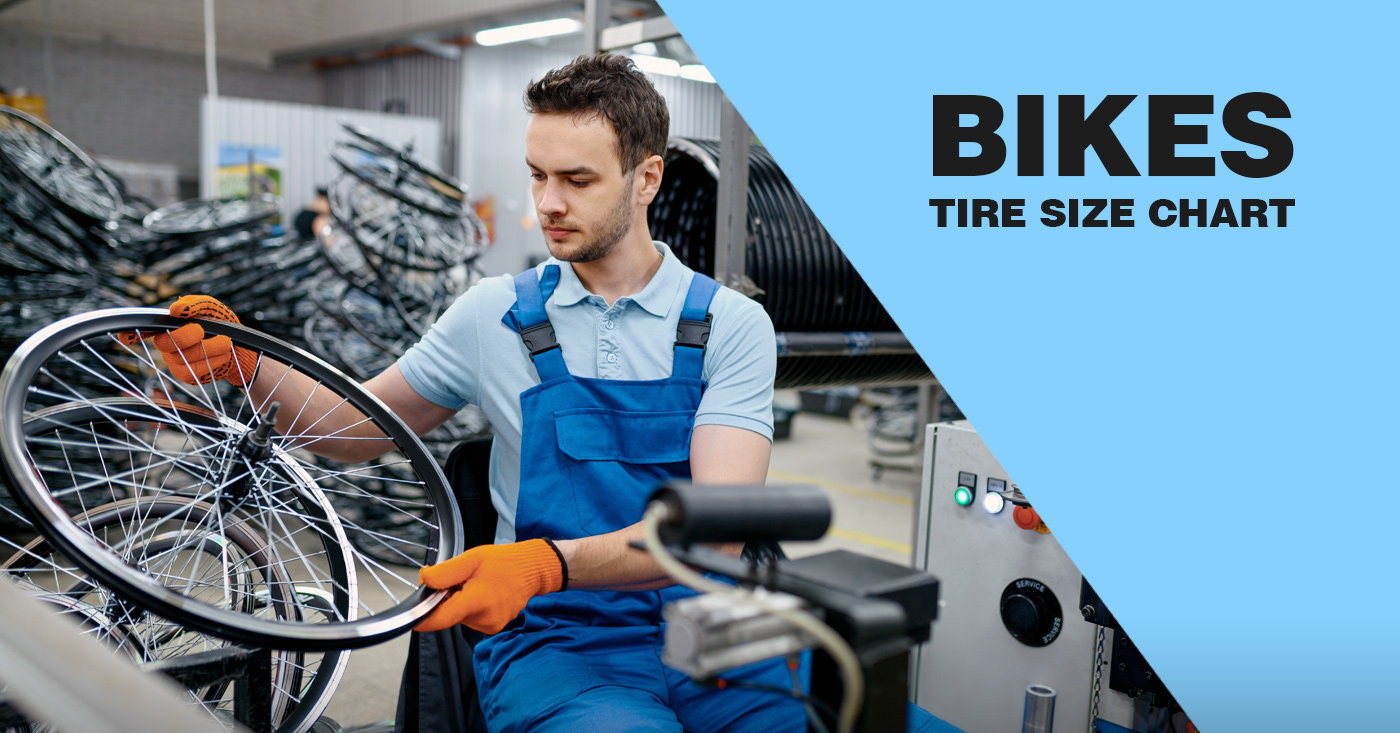Flat bike tires are one of the biggest frustrations you have to face as a bike owner. It doesn’t mean that you are neglecting your bicycle. However, that is one of the reasons that bicycle tires go flat. Other reasons include a worn-out bicycle tire, problems with the tube, or maybe a person pinching your wheel leading to a flat tire!
Yes, I know. It is frustrating. But hey, the first step in solving a problem is recognizing the cause of it! Isn’t it? So how about we explore the reasons?
Why Are You Having A Flat Bike Tire?
There are a lot of reasons for flat tires that you need to know. The most common are:
- Stuck Debris In Tires
- Inadequately Inflated Tires
- Worn Or Cracked Tires
- Problems With The Bike Wheel
- Very High Or Low Levels Of Pressure
- Defective Valve On Your Bike Tire
- Being Careless On The Road (Running Over Everything)

1. Be Aware of Pneumatic Bike Tires
Pneumatic Bike Tires have gained a lot of popularity over the last couple of years. Most people don’t know that these types of tires are prone to flats more compared to solid tires. Their repairing process is also difficult. One of the easiest methods is to inflate them directly with your bike pump. If you can’t use a bike pump then I’d recommend getting the help of a professional.
2. Tubeless Bike Tires
With Tubeless bike tires there is still a chance that you face a pressure loss. The best approach for this kind of problem is to remove any kind of old patches there are and fill them up with air. You could do this or you can just directly inflate your tube, both ways work.
Once you are done inflating the patch, place it very carefully over the hole before you reinstall it.
3. Rim Deformation Is A Real Problem
Chances are the Rim Deformation is the real cause of why your tires are wearing out more quickly than before. They could even bulge out on the circumference if you are not careful enough.
Don’t compromise your safety while cycling. Check out our guide to bike tire expiry and ensure you’re always riding on safe tires
4. You Could Have Rim Deformation
Apart from rim deformation, faulty valves could also be the culprits. How can you know that you have a faulty valve? When your bike air leaks between the expansion and contraction cycles, this is an indicator of a faulty valve.
How can you solve these problems? Make sure that there is always enough tread left appearing round and it should be without any sharp ridges.
5. Your Tires Might Be Burping
Did you know that your tires could burp? There are two types of burping. One is when they lose air. In the second type of burping, tires release CO2-rich fluids. When this happens you will hear a “POP” kind of sound.
Fixing the burping issue is very easy, just place your bike tire in front of an open window. This will normalize the air movement and even fill up the pressure.
6. Damaged Valves Could Be The Problem
Another common reason for the tires going flat or deflated is because of damaged valves. You could be facing pinched Presta valve stems or pinch flatting. This happens when you don’t inflate your bike tires properly.
Looking to improve your cycling experience? Follow our guide to road bike tire pressure and take your cycling to the next level!
6 Signs To Look For When Bike Tires Don’t Hold Air
Did everything you could but still your bike tires can’t hold pressure properly? There are some signs that you will need to check out.
1. Examine The Tire Tread Properly
Sometimes there could be thorns and debris stuck in your tire treads. Most tire treads have a very thin print. This makes them less resistant to scratches, thorns, and other harmful objects. Still, I would recommend that you watch out when riding on such surfaces.
See if they are worn out or not. There is a good chance that they may need some patching or you might have to change them. Examine the tread with a spare wheel, this will save you from a lot of trouble.

2. Examine The Tire Sidewalls
There is a good chance that the sidewalls of your tires are damaged by debris or any other object. This happens when your tires are completely worn out. Look for any cuts. If you across some bruises that are running over, it means that you have been riding on along pothole-riddled roads or worse!
3. Check Sealant Levels In The Case Of Tubeless Tires
If you have new tubeless tires and they are losing pressure, check out their pressure levels. I’d recommend that you check your tire pressure level before heading out for the day.
Check the tubeless tires for any bubbles or cracks between the layers. They are dangerous because they can cause an explosion while riding on technical and rough terrain. Fix them if you find any!
Don’t let a flat tire stop you from cycling. Check out our guide to learn how to fix your bicycle tire when it won’t inflate and get back on the road!
4. Make Sure The Tires Have The Recommended Pressure Level
Do I even need to say this? Make sure that your bike tires have the recommended pressure level.
| Bike Type | PSI Range |
|---|---|
| Kid's Bikes | 20-40 PSI |
| Road Bikes | 80-131 PSI |
| Hybrid Bikes | 50-70 PSI |
| Mountain Bikes | 30 PSI (Off-Road) 50 PSI (On-Road) |
5. Examine The Valve Properly
Tire valves could also be the reason why you are facing flat tires. Make sure to tighten all the valves before you head out. Pay extra attention to tubes, puncture-resistant inner cores, and rim wheels. They can lose air very easily. If you are going to ride in wet conditions then the valves on your bike components need to be extra tight. Or else, they will cause a lot of discomfort.
Here’s how you can fix a leaky tire Presta Valve Stem:
Tips and Tricks To Limit Bike Tire Pressure Loss
You can limit the whole process of bike tire air loss with regular maintenance. Try out these tips and tricks to limit your pressure loss!
1. Try Pumping Them Again
If your bicycle tires are losing air then you can try pumping them again, but inflate them properly. You can try dropping the pressure and pushing it back into shape. Just to see what kind of effect it would have. If this is not solving your problems then maybe your inner tube has caught water or debris which is making the whole process difficult.
Tired of dealing with flat tires? Check out our guide to learn how to prevent your bike tire from popping and enjoy a smooth ride!
2. Repair The Puncture Properly
You could face tube bursts or even a hole could develop on your tire. This is the time to go easy on the air pump rather than letting everything loose. Apply nominal pressure at first to repair the puncture. If you don’t, it may leak more air in the process.
If there is no progression then you will have to replace the damaged tire.

3. Warm Up The Tire
Before going out for a ride, you can warm up the tire to 40 degrees (Celsius) or 180 degrees (Fahrenheit). This will automatically reduce the pressure that builds itself due to the wind. Once your tires are warmed up, you will need to have them ready with 20 PSI. This is where you have to gradually raise the air back without opening the valve.
Get the most out of your cycling experience with our guide to checking tire pressure. Check it out now!
4. Some Additional Tips
Here are some additional tips that you should keep in mind.
- Pressure range will vary from one wheel size to the other as they come in different sizes.
- If you are carrying more cargo on the bike then it is better to increase the pressure.
- Lower tire pressures are great for comfort and grip while higher pressures promote speed.
- Modern road, gravel, mountain, and hybrid bikes have widened tire widths for comfort. This is why you should fill them up with higher pressure.
What To Do When Bike Tires Lose Pressure?
| Reason | Explanation |
|---|---|
| Bike Tire Porosity | Bike tires are more porous, allowing air to escape naturally. The surface-to-volume ratio is larger, causing air to escape more quickly than car tires. |
| Pressure Loss | Bike tires, holding high pressure, experience some pressure loss naturally. Regularly checking tire pressure helps limit the loss and ensures proper inflation. |
| Tire Inspection | Checking bike tire pressure before a ride is recommended to avoid unexpected flat tires. The slimmer and less dense structure of bike tires allows air to escape more quickly. |
| Flat Tire Repairs | Properly repairing flat tires is crucial. Inadequate repairs, where debris is not removed, can lead to continued pressure loss even after the repair. |
| Preventive Examination | Regularly spending time examining bike tires for debris and potential issues before riding can save you from future troubles and ensure a safe ride. |
You shouldn’t ride with a flat tire! Read this guide to know what I mean!
Other Problems That You May Face With Bike Tires
I have explained why your bike tires could be having a pressure loss or why you might be getting flat tires but there are also some other bike tire problems you can face.
| Problem | Solution |
|---|---|
| Bike tire issues (bulging, improper inflation) | Get a new bike tire, and inspect it thoroughly before installation. Consider a tubeless tire. |
| Punctured inner tube |
|
| Wheel problems (shaking, wobbling) | Inspect wheel components (bearing, axle, spokes). Replace damaged parts. If issues persist, consult a professional mechanic. |
| Bike tires going flat in cold weather | Gradual air pressure loss in cold weather due to water vapor separation. Monitor tire pressure and reinflate as needed in colder temperatures. |
You can also check out our guide on how to inflate a tubeless tire.
Recap
Delaying flat tire repairs is not helpful because it will lead to getting a replacement. Replacements are not cheap! Your tires could lose pressure without causing a flat. This can lead to a flat. Bike tires stay inflated for a week to ten days max. If they start deflating before that then there could be an issue.
If you can’t seem to fix the problem on your own, I suggest that you consult a professional. Or you can reach out to me in the comment sections below!
Also Read
Should you have any questions or require further clarification on the topic, please feel free to connect with our expert author Luke Ameen by leaving a comment below. We value your engagement and are here to assist you.









